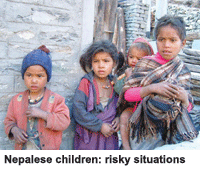Millions of children from marginalised ethnic families in Nepal are drifting out of education because not enough is being done to keep them in school, warn aid workers. “Enroling them in school and simply providing scholarships is not enough to ensure they continue going to school,” says Bhaya Ram Yadav from the Jana Jagran Yuba Club, an NGO which works with disadvantaged children in Bara district, 200 km south of Kathmandu.
 Bara has one of the worst literacy rates in this Himalayan nation, with only 27 percent female and 53 percent male literacy, well below the national averages of 44 and 68 percent respectively, according to the department of education. All over Nepal, marginalised families cannot afford to keep their children in school and most students from disadvantaged backgrounds drop out before class II.
Bara has one of the worst literacy rates in this Himalayan nation, with only 27 percent female and 53 percent male literacy, well below the national averages of 44 and 68 percent respectively, according to the department of education. All over Nepal, marginalised families cannot afford to keep their children in school and most students from disadvantaged backgrounds drop out before class II.
There are more than 100 ethnic groups in Nepal, half of whom are indigenous and marginalised, with 22 groups classified as “extremely disadvantaged”. They constitute about 40 percent of the country’s 29.3 million inhabitants, while almost one-third of all Nepalese live below the poverty line on less than US$1 per day.
“These groups also have the lowest number of children in schools,” says education specialist Helen Sherpa from World Education, an international NGO working with disadvantaged children. World Education has supported more than 150,000 children by rescuing them from exploitative work conditions, providing scholarships and helping their parents find income-generating activities. “They come from the most exploited communities which are impoverished, suffer from social inequalities and most children have dropped out of school to work in risky situations,” says Sherpa.
More than one million children in Nepal work as domestic servants, porters, carpet weavers, bricklayers and miners, according to the International Labour Organisation (ILO), which estimates there are about 55,000 children working as domestic servants and more than 16,000 in adult establishments, such as massage parlours and dance bars.
Nepal has 7.3 million students in the school system at primary, secondary and high-school levels, according to the Department of Education, but only 116,000 are from marginalised backgrounds. To combat the problem, the government has a programme of community schooling, whereby local communities take over management responsibilities in schools; 60 percent of the funding comes from the government and the rest from the communities.
But observers are not convinced the initiative is having the desired effect. “This is a good idea, but it does not solve the problem of equality issues in diverse communities in Nepal, as not all communities are capable of managing schools, especially in low-literacy areas,” says education specialist Sumon Tuladhar from the UN Children’s Agency (Unicef). These low-literacy areas cover about two-thirds of the country.
The government has provided 2.4 million scholarships over the past ten years for students up to class VIII, but NGOs say the impact has been minimal because the scholarships are only $5 per child annually. “That amount does not even cover the school fees in most public schools,” says Prakash Adhikari, executive president of the Innovative Forum for Community Development.
(Excerpted and adapted from www.irinnews.org)